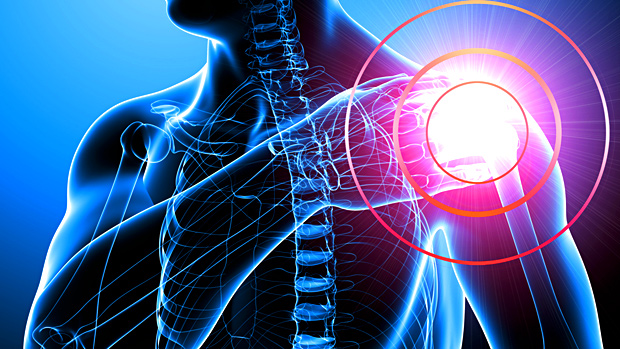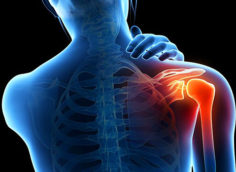Squats and Shoulder Pain
The squat is a staple. It's foundational to many other lifts.
If you've experienced any increased shoulder pain from doing it, you're already be aware that squatting and shoulder health are related in some way.
How exactly are they connected? And how can we fix what's causing the pain?
Before checking yourself into physical therapy for the next three months and draining your bank account, evaluate your squat: the setup, variations you use, and your loading patterns.
Fixing Your Setup

First, don't squat heavy the day after a taxing shoulder or chest-heavy training session.
If you read any notable program that's been released since the inception of the barbell, they all follow this golden rule. Why?
As you damage active tissues during a press-heavy training day, those tissues will immediately start the rebuilding process. Rebuilding tissue involves localized edema formation (fluid retention) encompassing the active joints and tissues that have just been insulted secondary to training.
This will increase the tone of the muscles - mainly the internal rotators of the shoulder joint along with the other players of the press.
Even the smallest amount of fluid buildup in a region of the body will decrease the available area for tendons and muscles to smoothly move through. More space filled up by viscous fluid doesn't help us with mobility.
More tendon friction and less tissue mobility leads to you having a hard time optimally setting up your shoulders in a squat position.
If movement isn't coming from your shoulders, you damn well know it's going to come from somewhere else. This fact predisposes the shoulders, elbows, and spine to compensate in ways that could potentially lead to injury.
The Fix
Just hit legs before you press.


Do you squat with a high bar or low bar? Be aware of how various bar positions make your shoulders feel.
The low bar position requires more mobility of the shoulder. In geek-speak, this means that you'll have to achieve both an externally rotated gleno-humeral position and accentuated adducted humeral position when compared to the high bar alternative.
The bar position has a huge influence on the positions of the rest of the kinematic chain, including torso angle, recruitment patterns around the muscles of the hip, along with chosen foot placements and tibial angles.
These variables are sometimes the origin of shoulder dysfunction.
The high bar position can be just as painful as the low bar, especially for those who've never deloaded the lift or played with the different positions of the squat setup.
The Fix
Alter bar placement. If the only variation you do is the low-bar squat, this may be your simplest, most powerful solution.
Before you jump on my back and say that bar position is sport specific, hold on one second. Your shoulder getting torn to shreds doesn't care about what sport you participate in.
Be smart and use intelligently programmed variations and modifications when warranted.


Do you use a wide or narrow grip? In terms of back squatting, the bar position and the grip really go hand in hand, pun intended.
Just as the low bar position requires an increased amount of mobility, the narrow-hand grip can also alter gross mechanics of the upper torso.
As your hands get more narrow on the bar, the shoulders must have the capacity to move into a highly adducted humeral position, one that places serious stress through the front of the shoulders from a near end range externally rotated position.
For some this can be a bad thing.
On the flip side, this hand position can also create some serious stability through the gleno-humeral and scapula-thoracic joints that can stabilize the spine better than the wide grip position.
The Fix
There's no magic ratio to tell you how wide your hands need to be to avoid pain. Find the middle ground between optimal shoulder and spine stability and comfortable shoulder positioning.
The optimal hand positions vary from person to person, but test out a wider hand position if you've been experiencing pain.
Increase slowly and with caution. If you have the patience to test some new grips, you'll be rewarded with a squat that's not only pain-free but provides some pretty good thoracic stability as well.
Even when your programming is sound and your bar height and hand placement is pristine, you still have to un-rack that bar and walk out of the rack like a pro to protect your shoulders.
I've seen everything from lunging the bar out of the rack to taking so many steps to get set that the chances of staying tight are slim to none. This is the final aspect of the setup, and it's the one in which I notice the most issues.
The Fix
A correct un-racking of the barbell out of the squat rack should look like a miniature version of the squat itself.
Foot placement, spinal stability, and pillar torque and tension should all be maintained before that bar leaves the rack.
Once you've gotten to that point, mini-squat that bar out of the rack. Think of it as a four-inch squat.
Keeping the entire torso stabilized, take one step back followed by a second step back by the opposite foot to get into position with no compensatory shifting.
Before you even squat with a barbell, master this part. Earn the right to use big boy training tools.

If your spine falls into a forward flexed position, it doesn't matter how great your shoulder mobility is, you're still at risk of shoulder issues.
Before you get on the physical therapist's table, ask yourself this question:
Is your thoracic spine always kyphotic (hunched over), or is that position accentuated when you back squat?
The answer may save you a lot of time and energy looking for problems that don't actually exist.
The Fix
Break out your cell phone and have your gym bro video your next set of squats.
Then grab a dumbbell and hold it in a goblet position, using the same foot position, torso angle, and setup as you did on the barbell lift. Get a set of dumbbell goblet squats on video.
Does your spinal position look better during the goblet squat, or is it strikingly similar to the back squat?
If the goblet squat cleaned up your spinal positioning, your ability to get to a neutral spine under load is there. It's time to enhance your motor control using that implement.
Does the goblet squat still suck and look just as bad as the barbell? Move onto the next section.
Here's how to figure out if you have enough mobility to make it through a squat day without pain, or if you have to remediate your mobility just to squat another day.
This is a screen I picked up from Kelly Starrett. Place a dowel in your hands and position your elbows to 90 degrees while your upper arms are parallel with the ground.
From that starting position, externally rotate your shoulders back as far as you can get them without compensating from the spine or head. As soon as you reach end range of motion, start to depress the dowel slowly and under control.
Go down until you can no longer get it any lower. You'll come to a point where the dowel hits up against your back at a certain level.
Is the level of the dowel currently lower than your chosen bar position? If it is, move on for now. If not, time to fix your mobility.
The Fix
If you need to improve your thoracic position with the barbell on your back, a great tool for linking the external rotation of the shoulder with the extension of the thoracic spine is quadruped thoracic spine rotation.
The bottom position of the squat is the range most susceptible to thoracic rounding. So try the movement above.
If you're a mobility-limited lifter, some basic movement remediation can be achieved through dynamic stretching of the pectoralis group along with the internal rotators.
These are not static stretches, but rather strategic oscillating stretches that produce quick, transferable results.
Mobility gets blamed for shoulder pain, lower back problems, and global warming. But not everything is a mobility problem.
Take a look at the stability of the shoulder if you passed the mobility tests above. Achieving a stable shoulder position is important. Here's what needs to happen:
First, gleno-humeral joint centration has to happen to place the ball of the humerus in a solid position in the glenoid fossa of the shoulder blade.
This position is found in terminal external rotation of the shoulder in addition to humeral extension and adduction. This is step one.
Step two, use the soft tissues encompassing the joint itself to create spiral tension loading and torque to really wind up all available contractile and non-contractile tissue to hold that perfectly centrated joint in position.
The cue "pull the bar apart" has been used for years. This is what coaches are getting at with this coaching method.
The ability to get into a centrated position is largely dependent on mobility. If you can't achieve this position, see the above corrections for remediation of your mobility deficit.
If you're having difficulty finding torque through the shoulder complex, I have seen this to be a motor control issue that needs some re-patterning.
The Fix
Depending on how severe the motor control deficit is, there are a few drills you can go through to learn how to feel torque and generate some serious spiral tension loading through the shoulder joint.
Start off simple, generating torque from a supine position with the use of bands, then move into a quadruped position. If you graduate from all fours, the half kneeling and standing positions are used.
If and when you're ready to progress back to the barbell, this skill can be directly transferrable to the iron.

If you've made it through to this point with no resolve, you've run out of self-sufficient options to remediate your squatter's shoulder.
Be sure that you haven't overlooked any aspects of the squat setup or internal movement mechanics above.
It's important to mention that this stage is where most people start. They want a complex diagnosis for an easy fix.
Your body is yours and yours alone. Take care of it until you've exhausted all conservative measures. Then get a professional evaluation.
The Fix
Seek a qualified sports performance physical therapist, chiropractor, or rehab professional.
Just because people sport a "Dr." in front of their name doesn't mean they're all equally qualified to evaluate, assess, and treat a strength athlete with specific training goals in mind.
These are few and far between, but if training is truly a passion and you plan on doing this the rest of your life, spending the extra effort vetting your rehab doc will pay off in the end.
Have a trusted professional in your back pocket to get better and be able to push harder in your training.





